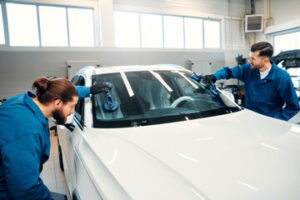Mechanics work in physically demanding environments, including exposure to particulate dust from sanding bodywork or toxic chemical fumes from paint and related products. They must also keep up with technical advancements in vehicles and their systems.

Stick to a shop that is familiar with your vehicle’s make. This way, they can identify issues early and prevent them from escalating. Contact Auto Repair In Antioch CA for professional help.
The automotive repair industry is a multifaceted sector that plays an important role in the safety and reliability of vehicles. It encompasses everything from routine maintenance to complex repairs and auto parts replacement. The industry is also influenced by technological advancements, environmental concerns, and shifting consumer behaviors. Various repair facilities exist within the industry, including independent shops, dealership service centers, and chain stores.
A consistent maintenance strategy is critical for the optimal performance of a vehicle. Routine oil changes, tune-ups, and inspections can help prevent major issues and keep a car running at its best for years to come. Proper care and maintenance also helps ensure that a vehicle is safe to drive, particularly during inclement weather conditions.
Mechanics should undergo extensive training to learn the necessary skills to work on different types of cars. This includes learning how to diagnose problems and identify potential solutions. In addition, mechanics should stay updated on the latest technology and techniques used in the automotive repair industry.
Some automotive maintenance tasks can be performed at home, but other repairs may require specialized equipment or expertise. For example, replacing worn windshield wipers or addressing other minor concerns is easy enough for most people to do on their own, but replacing a defective engine or transmission requires specialized knowledge and equipment.
Regular maintenance is one of the most effective ways to reduce the risk of vehicle breakdowns and costly repairs. It is essential to follow the manufacturer-recommended maintenance schedule for each vehicle. For instance, a routine oil change every 3,000 miles is important for keeping a vehicle running smoothly.
It is also important to get regular tire rotations and balancing to extend the life of a vehicle’s tires. In addition, addressing small repairs quickly, such as a cracked or broken windshield, is a good way to prevent accidents and reduce the risk of injury to other drivers on the road.
Keeping customers loyal to your shop is essential for maximizing revenue and achieving success in the automotive repair industry. A great way to do this is by offering incentives like discounts or loyalty schemes. However, it is important to carefully evaluate the cost of these promotions to ensure that they don’t significantly cut into your margins.
Diagnostics
When something goes wrong with your vehicle, getting an accurate diagnosis is the key to making the right repairs. Auto diagnostics use scanners and computers to read error codes from a car’s computer systems and translate them into information mechanics can understand. This allows them to pinpoint the exact cause of the problem and address it effectively.
Modern vehicles have complex network of intricate systems that work together to ensure a safe and reliable ride. These systems rely on sensors and computer modules to function, and when they don’t work as they should, it can be difficult for mechanics to pinpoint the issue. Diagnostics help them make fast and accurate repairs, saving time and money for car owners.
The benefits of auto diagnostics are vast and varied, but some of the most significant include:
Improved Performance
Diagnostic testing helps to keep your engine running at its best. It can identify efficiency-draining problems like a bad oxygen sensor or clogged air filter, and enable you to address them promptly. This can lead to improved fuel economy and a more enjoyable driving experience.
Cost-Effective Solutions
Diagnostics provide clear information about what needs to be repaired, allowing technicians to recommend targeted repairs that avoid unnecessary parts replacements and associated costs. This can save you a lot of money in the long run while also ensuring that your repair bill is as low as possible.
Safety and Security
Diagnostic tools can find a wide range of issues that can affect your car’s safety, from the simple (like a low tire pressure indicator) to the more complex (like an engine misfire or faulty ignition coil). They can even pick up on potential hazards like malfunctioning brakes or steering issues that could lead to accidents.
Ultimately, auto diagnostics are an essential tool for anyone who cares about their vehicle. By nipping problems in the bud, they can prevent them from spiraling out of control and keeping you off the road for longer than necessary. They can also help you get the most out of your car by reducing unnecessary wear and tear, ensuring that it runs smoothly for years to come and retains its value when you’re ready to sell it down the line.
Repairs
As the name suggests, auto repair encompasses any process that fixes or maintains vehicles, primarily automobiles. This may include anything from routine maintenance tasks such as oil changes, air filter replacements, and fluid checks to the more involved repairs like engine overhauls and transmission work. The primary objectives of auto repair are to ensure a vehicle’s safety, performance, and reliability.
While neglecting routine maintenance can lead to expensive and potentially dangerous problems, timely auto repairs are essential for ensuring your vehicle’s longevity. Having your car repaired as needed can also help preserve its resale value, making it more attractive to potential buyers down the line.
Even minor issues can have a big impact on the lifespan of your car. Addressing these problems promptly can prevent them from becoming bigger issues that require costly repair or even total replacement. Whether it’s an oil leak, loose tire, or broken headlight, catching these issues quickly can save you money and inconvenience in the long run.
Getting the right repair work done by an experienced and professional mechanic can make all the difference in the life of your car. A skilled automotive technician can diagnose and fix your vehicle’s problem quickly, accurately, and at an affordable price.
While auto repair costs do rise over time due to inflation and the higher cost of parts and overhead, getting quality repair work is still possible. When choosing a shop, consider asking friends or neighbors for recommendations and check the shops’ ratings with the Better Business Bureau and Office of Consumer Protection.
Aside from the normal wear and tear, unexpected auto repairs can happen due to accidents or other factors beyond your control. If you have a warranty on your car, getting the repair work done in a timely manner can help you avoid high out-of-pocket costs and minimize the impact on your finances.
Warranty
A warranty is the promise from a repair shop to cover the cost of repairs for a set period of time or miles. This type of coverage is often offered by auto dealerships or independent repair shops. When deciding whether or not to purchase a warranty, there are several factors to consider.
Purchasing a car is a major financial commitment, and it’s natural to expect that some wear and tear will occur over the course of ownership. When a repair bill comes, it can cause stress and strain on your budget, especially if you don’t have the funds to cover it. Warranty coverage is a valuable tool to help alleviate the worry of unexpected repair costs.
Repair warranties offer the assurance that a repair shop stands behind its work and parts installation. It also ensures that if the same issue is found to be present again, the repair center will cover it. In addition to providing financial protection, repair warranties can be transferable, meaning you’ll receive the benefit of its use by a future owner of the vehicle.
When it comes to selecting a shop that offers warranty coverage, it’s important to do your research. Not all repair warranties are created equal, and some may not cover the specific components you need covered. Choosing a repair shop with experience in car maintenance and repairs will make it easier to navigate warranty terms and limitations while ensuring you’re getting the best service for your money.
Aside from the financial benefits of having a repair warranty, it can be an effective way to encourage routine maintenance services, which can catch issues before they escalate into costly and complex problems. Ultimately, this can reduce the need for repairs and extend the lifespan of your vehicle.
Having a repair warranty in place can also enhance your vehicle’s resale value. Many prospective buyers are drawn to vehicles with warranties still in effect, as it can be a signal that the vehicle is well-maintained and cared for. In a world where unexpected repairs can easily drain your wallet, it’s more important than ever to have auto repair warranties in place to protect yourself and your investment.

